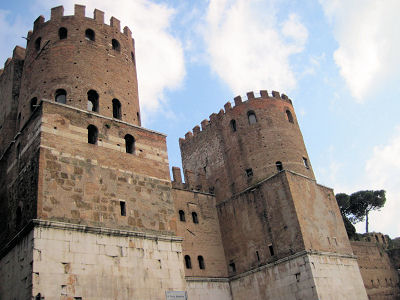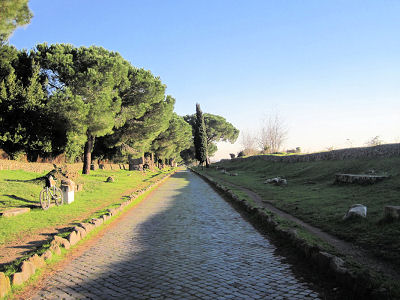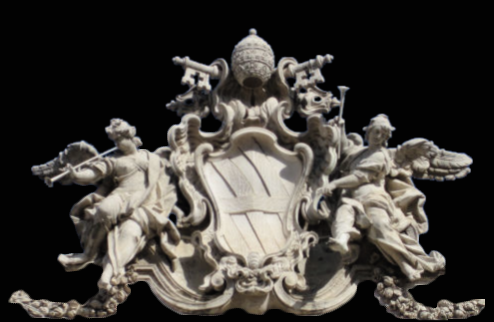| Catacombs and Ancient Appian Way
 The historical center of Rome is defined by the imposing walls built by Emperor Aurelian in the 3rd century AD. The walls are 11 miles long (19 km) and are still perfectly preserved having been functional for the defense of the city until Rome became the capital of Italy in 1870. The historical center of Rome is defined by the imposing walls built by Emperor Aurelian in the 3rd century AD. The walls are 11 miles long (19 km) and are still perfectly preserved having been functional for the defense of the city until Rome became the capital of Italy in 1870.
There are several gates in the wall, corresponding to the main roads leaving the city. The Appian Gate, also known as the San Sebastian Gate, is the most monumental one because of the relevance of the ancient Appian Way leading south. It was considered the "Queen of the Roads."
On our tour, we will cross the Appian Gate to reach the catacombs located on the Appian Way. These were early Christian cemeteries excavated in the volcanic tufa stone to house the deceased of the Christian community from the 2nd to the 5th century AD.
 We'll walk along the Appian Way to explore the best preserved ancient circus in Rome, located in Emperor Maxentius's villa. Together with gladiatorial fights, chariot races were the favorite entertainment of the Romans. We'll talk about these dangerous games and about the actual size and building characteristics of the circuses. Not far away is the funerary monument of Maxentius's son Romolus. Further along there is one of the symbols of the Appian Way, the Mausoleum of Cecilia Metella, located in a dominating and prominent position with the aim of rendering perpetual glory to her family. Due to its location, it became the Caetani Fortress (of the famous Pope Bonface VIII). In the Middle Ages, it was used as a way to control and tax the travellers to Rome. We'll walk along the Appian Way to explore the best preserved ancient circus in Rome, located in Emperor Maxentius's villa. Together with gladiatorial fights, chariot races were the favorite entertainment of the Romans. We'll talk about these dangerous games and about the actual size and building characteristics of the circuses. Not far away is the funerary monument of Maxentius's son Romolus. Further along there is one of the symbols of the Appian Way, the Mausoleum of Cecilia Metella, located in a dominating and prominent position with the aim of rendering perpetual glory to her family. Due to its location, it became the Caetani Fortress (of the famous Pope Bonface VIII). In the Middle Ages, it was used as a way to control and tax the travellers to Rome.
|

 The historical center of Rome is defined by the imposing walls built by Emperor Aurelian in the 3rd century AD. The walls are 11 miles long (19 km) and are still perfectly preserved having been functional for the defense of the city until Rome became the capital of Italy in 1870.
The historical center of Rome is defined by the imposing walls built by Emperor Aurelian in the 3rd century AD. The walls are 11 miles long (19 km) and are still perfectly preserved having been functional for the defense of the city until Rome became the capital of Italy in 1870. We'll walk along the Appian Way to explore the best preserved ancient circus in Rome, located in Emperor Maxentius's villa. Together with gladiatorial fights, chariot races were the favorite entertainment of the Romans. We'll talk about these dangerous games and about the actual size and building characteristics of the circuses. Not far away is the funerary monument of Maxentius's son Romolus. Further along there is one of the symbols of the Appian Way, the Mausoleum of Cecilia Metella, located in a dominating and prominent position with the aim of rendering perpetual glory to her family. Due to its location, it became the Caetani Fortress (of the famous Pope Bonface VIII). In the Middle Ages, it was used as a way to control and tax the travellers to Rome.
We'll walk along the Appian Way to explore the best preserved ancient circus in Rome, located in Emperor Maxentius's villa. Together with gladiatorial fights, chariot races were the favorite entertainment of the Romans. We'll talk about these dangerous games and about the actual size and building characteristics of the circuses. Not far away is the funerary monument of Maxentius's son Romolus. Further along there is one of the symbols of the Appian Way, the Mausoleum of Cecilia Metella, located in a dominating and prominent position with the aim of rendering perpetual glory to her family. Due to its location, it became the Caetani Fortress (of the famous Pope Bonface VIII). In the Middle Ages, it was used as a way to control and tax the travellers to Rome.